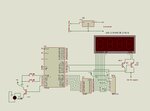tapu
Full Member level 4
Dear all,
I am using 2 inch seven segment display. For my project.but data is not showing in display.here I connect port of 8051to display directly (According to program)..is ic 2803 required for current sink??
I am using 2 inch seven segment display. For my project.but data is not showing in display.here I connect port of 8051to display directly (According to program)..is ic 2803 required for current sink??

